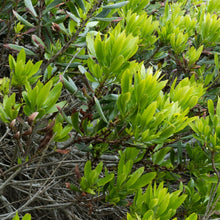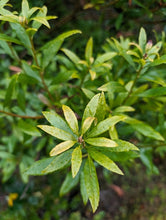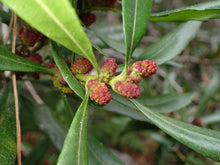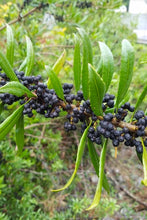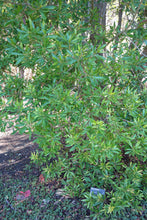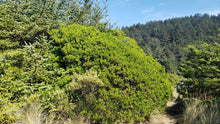
Myrica californica
Pacific wax myrtle is a fast-growing, large, evergreen shrub that functions perfectly as a screen or hedgerow (goodbye invasive laurel!). It has narrow, lance-shaped leaves that are glossy and smooth to the touch. Inconspicuous flowers arrive in spring and transform into clusters of small red to purple berries by fall that are a magnet for backyard birds and other wildlife.
- Plant type/canopy layer: evergreen, perennial, large shrub
- Size at maturity: 10’-30’ tall, 10’-20’ wide (can be heavily pruned into more narrow spaces)
- Light requirements: full sun, part-sun/part-shade
- Moisture requirements: moist to dry soil
- Bloom time: May - July
- Growth rate/ease: fast growing, very easy to grow
- Wildlife support: flowers attract and provide nectar to adult butterflies; berries are prized food for small mammals and birds; overall plant/vegetation is caterpillar host and larval food source for many species of native moths
- Native habitat/range: commonly found growing in coastal conifer forests, bogs, sand dunes, stream banks, wet meadows, marshes, and moist hillsides along the Pacific Northwest coastline from British Columbia through most of California, sea level to 1000m. Portland Plant List - no.
- Special features & uses: evergreen; wildlife favorite; deer resistant; drought-tolerant; landscape uses include rock gardens, habitat hedgerows and windbreaks, bank stabilization and erosion control
Gardening with Pacific Wax Myrtle: This hardy wonder shrub will not only tolerate, but will look stunning, in a wide variety of light and soil conditions. For best success, place it in a full to mostly sunny place with basically any soil type, from damp to dry, and plenty of room to grow. It’s roots have a relationship with nitrogen-fixing microorganisms, which allow it to grow in low-nutrient soils while enriching them over time. This plant makes an excellent hedge or screen, an ideal replacement for invasive laurel hedges. It wants to grow to become a gigantic beast, but is fine getting heavily pruned for narrow spaces.
Photo Credit 1 (foliage, square): © Ken-ichi Ueda, some rights reserved (CC-BY)
Photo Credit 2 (foliage): © Simone L, some rights reserved (CC-BY)
Photo Credit 3 (flowers, close-up): © Cricket Raspet, some rights reserved (CC-BY)
Photo Credit 4 (berries): © Mitch Van Dyke, some rights reserved (CC-BY)
Photo Credit 5: "Myrica californica - Leaning Pine Arboretum - DSC05800" by Daderot is marked with CC0 1.0.
Photo Credit 6 (in the wild): © Rupert Clayton, some rights reserved (CC-BY)






